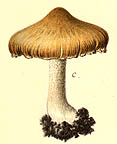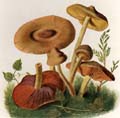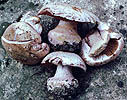Cortinarius argentatus
 Key to Gilled Mushrooms Key
Key to Gilled Mushrooms KeyThis is a key to gilled mushrooms, that is, mushrooms having a definite cap with a fertile surface consisting of gills. The fruiting body usually also has a stem, although that may be lateral or absent (usually, then, the mushroom is growing from wood). You can use this key to identify mushrooms that you find.
 Agaricales Order
Agaricales OrderFruiting body containing fibers (usually in the stalk)
 Brown, Olive, Orange or Tan Spored Suborder
Brown, Olive, Orange or Tan Spored SuborderGills not free
Spore print tan, orange, deep ochre, yellowish olive, olive brown, rusty or cinnamon brown or deep brown
Ring usually either absent or not membranous
 Terrestrial Brown Spored Family
Terrestrial Brown Spored FamilyGrowing on the ground
 Cortinarius Genus
Cortinarius GenusWith a cobwebby partial veil called a cortina
Stem often much wider at the base
Spore print usually rusty brown or cinnamon brown
 Sericeocybe Subgenus
Sericeocybe Subgenus
 Silvery Lilac Sericeocybe Section
Silvery Lilac Sericeocybe SectionEntire fruiting body silvery lilac
Flesh white to pale lilac, not mottled
Gills usually purple, until colored rusty brown by developing spores
Here are the characters that distinguish this species from the others in its group. For its more general characters, see higher up on the page.
If there's just a few words or a microscopic feature here, a more thorough description can be found above.
Diagnosis
- Cap up to 2 1/2" across
-
Gills purple until colored rusty brown by developing spores
-
Stalk gradually widening to a clublike base, but lacking the universal veil material
Microscropic Characters
Comments
There seem to be several different conceptions of this species floating around. It is given by several authors as a lookalike for Cortinarius alboviolaceus (along with its lookalike, Cortinarius subargentatus), but lacking the white universal veil material on the stalk base.
In comparing it with Cortinarius alboviolaceus, Arora (1986) says that C. argentatus has a bigger basal bulb, is bluer but tends to turn ochre in age, and has a radishlike odor. In his view, Cortinarius subargentatus is identical but lacks the odor.
R. Phillips (1991) simply gives Cortinarius subargentatus as a lookalike, but says that it lacks the sheating universal veil material.
N. S. Weber & A. H. Smith (1985) do not discuss similarities between the taxa and only give an entry for C. argentatus. However, white patches are clearly visible on the base of the clavate stalk in their photo; perhaps they consider it synonymous with Cortinarius alboviolaceus. As you can see the spores are about the same size, but then almost all Sericeocybes have spores that size, so who knows how significant that is.
Lincoff (1987) and A. E. Bessette, D. W. Fischer & A. R. Bessette (1997) are discreetly silent on this issue.
As soon as I learn The Truth, I will let you know...






 Key to Gilled Mushrooms Key
Key to Gilled Mushrooms Key Agaricales Order
Agaricales Order Brown, Olive, Orange or Tan Spored Suborder
Brown, Olive, Orange or Tan Spored Suborder Terrestrial Brown Spored Family
Terrestrial Brown Spored Family Sericeocybe Subgenus
Sericeocybe Subgenus Silvery Lilac Sericeocybe Section
Silvery Lilac Sericeocybe Section




